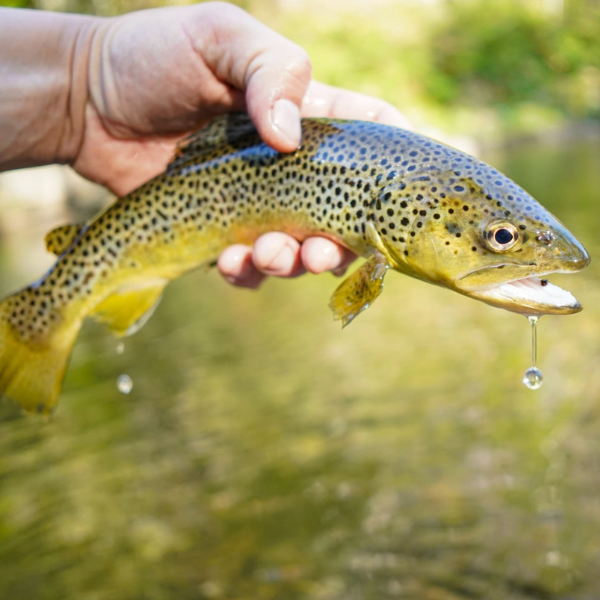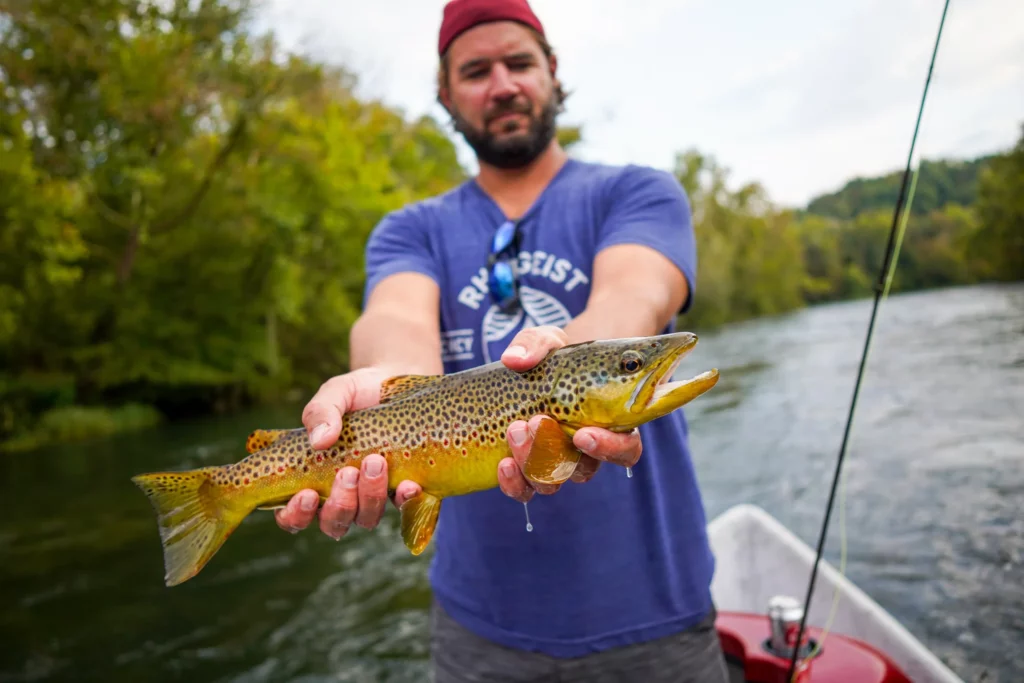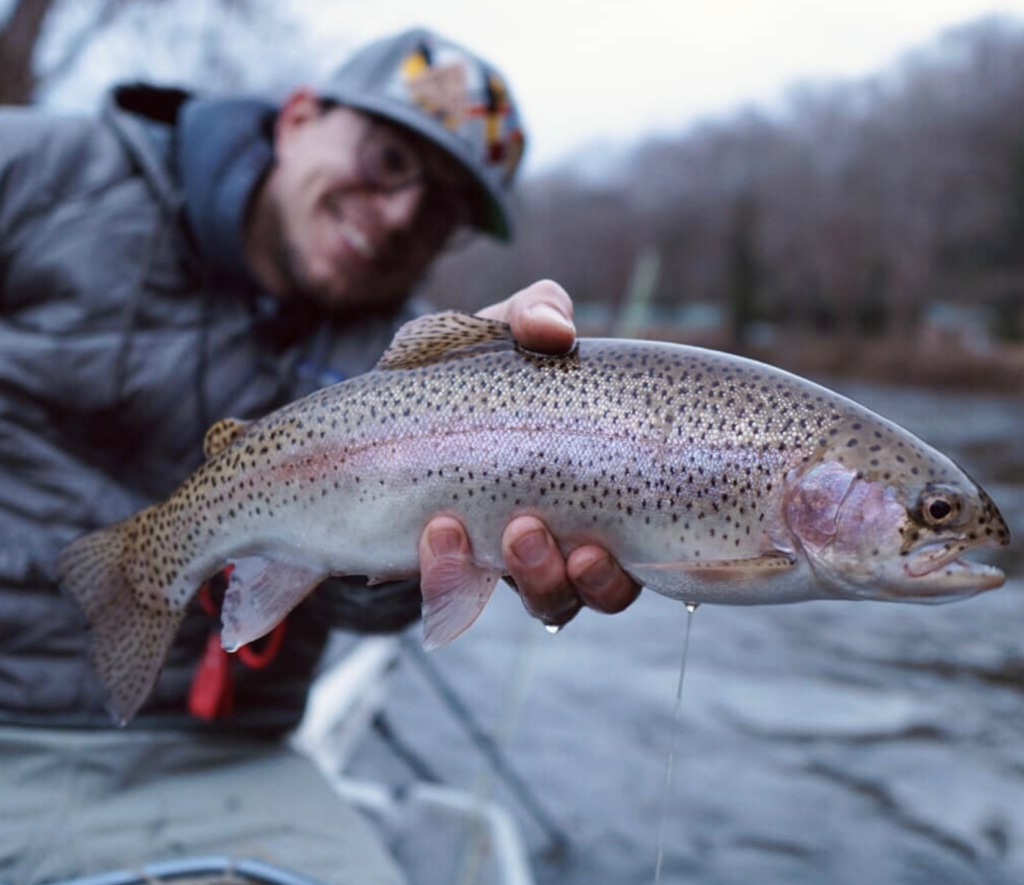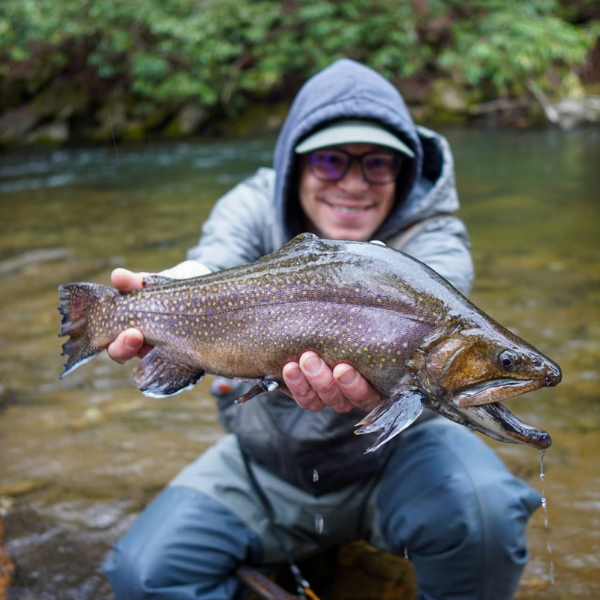
East Tennessee Fly Fishing: Top 5 Spots
Welcome to some of the best fly-fishing locations in the 33 counties of East Tennessee, and really some of the best in the Eastern United States. This region, with its sprawling landscapes and lush waterways, stands as a beacon for fly fishing enthusiasts seeking the quintessential American trout fishing experience. Nestled within the heart of the Appalachian Mountains, this region boasts a rich tapestry of rivers, streams, and lakes that offer some of the most picturesque and productive fly fishing spots in the country. The allure of East Tennessee is not just in its breathtaking beauty but also in the diverse aquatic ecosystems that make it a haven for a wide array of trout species.
Fly fishing in East Tennessee is a journey through a world where the wild and the stocked coexist harmoniously. Anglers can expect to encounter an impressive variety of trout, including the elusive wild brown trout, spirited wild rainbow trout, and the cherished native brook trout, alongside generously stocked rainbow and brown trout. This diversity allows for a fly fishing experience that is as rich and varied as the landscape itself. Whether you are wading through the freestone streams in search of wild trout or casting your line in the tailwaters for trophies, East Tennessee offers an unparalleled adventure for every fly fisher.
The aim of this article is to navigate you through the top 5 fly fishing spots in East Tennessee, detailing the unique attributes of each location to enhance your fishing expedition. We will explore the types of trout that populate these waters, from the spirited wild varieties to the bountiful stocked populations, ensuring you know exactly what to expect on your line. Additionally, we will dive into the best flies to carry in your arsenal for each spot, tailored to mimic the local hatch and maximize your catch rate. Understanding the optimal fishing times is crucial, and we will guide you through the best seasons, times of day, and environmental conditions to help you plan your trips for success.
Join us as we unveil the treasures of East Tennessee’s fly fishing destinations, providing you with the insider knowledge to make your next fly fishing trip both memorable and fruitful. Whether you’re a seasoned angler or new to the sport, the rivers and streams of East Tennessee await to offer you a fly fishing experience like no other.
The South Holston River
The South Holston River tailwater, running from Bristol to Bluff City, TN, stands as a premier destination for fly fishing, particularly renowned for its brown and rainbow trout populations. The SoHo, as locals call it, distinguishes itself not only through the scenic beauty it offers but also through the extraordinary density of trout that call it home. Among its most notable inhabitants are the wild brown trout, with an astonishing density of approximately 8,500 per mile. This remarkable figure highlights the South Holston as a haven for anglers seeking the thrill of catching these coveted fish in their natural habitat.
The wild brown trout in the South Holston River are esteemed for their intelligence and elusiveness, presenting anglers with a formidable challenge that is as rewarding as it is demanding. The river’s ecosystem supports a vibrant, self-sustaining population of these fish, making it an unparalleled fly fishing destination. Alongside the wild browns, the river is also stocked with rainbow trout, ensuring a rich and diverse fishing experience. The combination of wild and stocked trout makes every trip to the South Holston River a potential adventure, with the promise of both quantity and quality.

Best Flies for the South Holston
When targeting these brown trout, the choice of flies is paramount. Sulphurs, with their enticing appearance, are especially effective during their hatch period, closely imitating the insects that trout feed on naturally. Blue Winged Olives also play a critical role during the cooler months, offering a reliable option on overcast days when these insects are most active. For those aiming to catch the larger, more elusive brown trout, streamers are a must-have in your fly box, providing the illusion of baitfish that these predators cannot resist.
Best Times to Fish The South Holston
Understanding the optimal fishing times is crucial for maximizing your success on the South Holston River. In the summer, the best fishing occurs during the early mornings and late evenings, when the trout are most active and feeding at the surface. As the seasons change, the cooler months shift the prime fishing times to midday, when the sun has warmed the waters enough to stimulate trout activity, offering anglers the best chance to experience the river’s full potential.
The South Holston River’s combination of a high density of wild brown trout, strategic fly selection, and understanding of the best times to fish creates a fly fishing experience that is both challenging and immensely rewarding. With around 8,500 wild brown trout per mile, the river is a testament to the abundance and health of its aquatic life, making it a must-visit destination for any serious fly fisher.

The Watauga River
The Watauga River, whose headwaters start high in the North Carolina mountains, and tailwaters make its way through the picturesque landscapes of Elizabethton and Johnson City, Tennessee, offers a rich tapestry of fly fishing opportunities that captivate both novice and experienced anglers alike. This river is distinguished by its diverse population of trout, presenting a harmonious mix of wild and stocked varieties. Anglers are treated to the presence of wild brown trout, which add a layer of challenge and excitement to the fishing experience. Complementing these are the stocked rainbow and brook trout, ensuring that the river teems with life and offers ample opportunities for a rewarding day out on the water. The Watauga River’s ecosystem supports this vibrant mix, making it a destination of choice for those seeking variety and abundance in their fly fishing adventures.
Best Flies to Use on the Watauga River
Selecting the right flies is crucial for a successful outing on the Watauga River, with certain types proving particularly effective throughout the year.
Midges: These small yet potent flies are indispensable, especially during the colder months when trout feed on these insects extensively.
Caddis: A staple in the fly fisher’s arsenal, caddis imitations are effective during their hatch periods, closely mirroring the natural prey of the trout.
Nymphs: Offering a year-round option, nymphs mimic the larval stage of aquatic insects, appealing to the trout’s instinctual feeding habits and ensuring consistent bites.
Best Times to Fish the Watauga River
Timing your visit to the Watauga River can significantly enhance your fishing experience, with certain seasons offering optimal conditions.
Spring and Fall: These seasons are particularly fruitful for fly fishing on the Watauga River. During spring, the rebirth of nature triggers a surge in insect activity, leading to prolific hatches that trout find irresistible. Fall brings another peak in hatches, with the changing temperatures prompting increased trout activity. These periods not only promise beautiful scenery but also the best chances to witness the river’s full potential, with trout more likely to surface for their meals.
The Watauga River, with its blend of wild and stocked trout and strategic fly recommendations, offers a year-round fly fishing sanctuary. Whether you’re casting your line amidst the blossoming banks of spring or the crisp air of fall, this river ensures a memorable experience, underscored by the thrill of the catch and the beauty of East Tennessee’s natural landscapes.

The Clinch River
In the realm of East Tennessee’s fly fishing destinations, the Clinch River carves out a distinguished position with its exceptional waters that foster a thriving trout habitat. This river is particularly celebrated for its high-quality wild brown trout and abundantly stocked rainbow trout, creating a dynamic fishing environment that appeals to anglers of varying skills and preferences. The wild brown trout of the Clinch River are lauded for their size and the cunning challenge they present, offering the quintessential fly fishing challenge. Complementing these are the stocked rainbow trout, which ensure that anglers find consistent success and enjoyment in their pursuits.
Best Flies to Use on the Clinch River
Effective fly selection on the Clinch River is predicated on a deep understanding of the local hatch patterns and the feeding behaviors of its trout population.
Zebra Midges: These flies are indispensable in the colder months, providing a lifelike representation of the small insects that trout feed on extensively during this time.
Scuds: Acting as a reliable year-round option, scuds mimic the freshwater shrimp and other crustaceans that form a significant part of the trout’s diet in the Clinch River.
Sulphurs: During their hatch in the late spring and early summer, sulphur flies become particularly effective, closely imitating the natural prey of trout and enticing them to the surface.
Best Times to Fish the Clinch River
The Clinch River’s fly fishing success is significantly influenced by the water flow rates, which are dictated by the dam’s release schedule.
Water Flow Rates: Understanding and monitoring the scheduled water releases is crucial for planning a fruitful fishing trip. The periods following these releases offer optimal conditions, as the higher water levels dislodge insects from the riverbed, triggering a feeding frenzy among the trout.
Seasonal Considerations: While the river offers year-round fishing opportunities, the best times are often found in the spring and fall when the hatch activity is at its peak. These seasons not only provide the most scenic backdrop for fly fishing but also ensure that anglers experience the most active trout behavior.
The Clinch River, with its combination of high-quality trout, strategic fly recommendations, and the critical timing of water flows, stands as a testament to the richness of East Tennessee’s fly fishing landscapes. For those willing to adapt to its rhythms, the river promises an unmatched fly fishing adventure, marked by the thrill of the catch and the beauty of its natural surroundings.
The Little River
The Little River, meandering through the scenic landscapes of the Great Smoky Mountains outside of Gatlinburg, is a fly fishing destination of remarkable beauty and biodiversity. Renowned for its abundance of wild rainbow trout, the river offers anglers the rare opportunity to engage with fish that have thrived in these waters for generations. Adding to the allure is the occasional brook trout found in the river’s higher elevations, presenting a delightful challenge for those willing to explore the more secluded stretches and get away from the crowds. The presence of these wild trout, thriving in the pristine conditions of the Little River, epitomizes the pure essence of fly fishing in the heart of nature.

Best Flies to Use on the Little River
Selecting the right flies for the Little River can greatly enhance the fly fishing experience, with certain types proving particularly effective across the different seasons.
Terrestrials: During the warm summer months, terrestrial flies such as grasshoppers, beetles, and ants become invaluable, perfectly imitating the insects that often fall into the water, becoming an easy meal for trout.
Blue Winged Olives: As fall approaches, these mayflies emerge as a prime choice, especially on overcast days when these insects are most active, offering a feast for the trout.
Nymphs: In the colder months, nymphs provide a consistent option, appealing to the trout’s tendency to feed on subsurface prey, thereby increasing the chances of a successful catch.
Best Times to Fish the Little River
Timing is a crucial factor in maximizing the fly fishing experience on the Little River, with certain periods offering more rewarding opportunities.
Late Spring to Early Fall: This timeframe is particularly conducive to fly fishing, as the river comes alive with increased insect activity and more active trout. The late spring heralds the beginning of an abundant fishing season, which peaks during the summer and extends into the early fall.
Early Morning and Late Evening: These times are especially magical on the Little River, as the lower light levels encourage trout to feed more aggressively at the surface, creating ideal conditions for dry fly fishing.
The Little River, with its wild rainbow and brook trout, tailored fly recommendations, and optimal fishing times, invites anglers to immerse themselves in an authentic fly fishing adventure. This river not only challenges and rewards in equal measure but also offers a serene escape into the untouched beauty of East Tennessee’s natural landscapes.

The Tellico River
Nestled in the lush forests of the Cherokee National Forest in East Tennessee, the Tellico River is a celebrated fly fishing destination, renowned for its large rainbow trout and the elusive native brook trout found in its tributaries. This river has built a reputation as a go-to spot for anglers aiming to hook into trophy-sized rainbows, thanks to the Tennessee Wildlife Resources Agency’s regular stocking efforts. Additionally, the higher, more secluded reaches of its tributaries offer a serene and challenging fishing experience for those in pursuit of native brook trout, providing a pristine and untouched fishing environment that is as rewarding as it is beautiful.
Best Flies to Use on the Tellico River
The diverse aquatic environments of the Tellico River demand a versatile fly box, with specific patterns standing out for their effectiveness throughout the year.
Stoneflies: With their robust size and tempting silhouette, stonefly patterns are particularly effective in the early parts of the year, closely mimicking one of the native brook trout’s favorite meals.
March Browns: These flies come into their own in the spring, offering an excellent imitation of the natural insects that hatch during this season, enticing both rainbow and brook trout to the surface.
Wooly Buggers: A versatile and effective fly, wooly buggers can be used throughout the year to mimic a variety of prey, from baitfish to leeches, appealing to the aggressive feeding habits of larger trout.
Best Times to Fish the Tellico River
Selecting the optimal time to fish the Tellico River can greatly enhance the fly fishing experience, with specific periods offering the most favorable conditions.
Spring and Early Summer: These seasons are particularly advantageous for fly fishing on the Tellico River. Spring brings about a surge in insect activity and trout feeding behavior, making it an ideal time for dry fly and nymph fishing. The early summer continues this trend, with warmer temperatures and increased hatches providing abundant opportunities for anglers.
Delayed Harvest Regulations: It’s important for anglers to be aware of the delayed harvest regulations that are in place during certain times of the year. These regulations, designed to protect the trout population and improve fishing quality, restrict the types of fishing techniques and times you can fish, emphasizing catch and release with artificial flies only during these periods.
The Tellico River, with its abundant stocked rainbow trout, challenging native brook trout, and recommended flies, offers a quintessential East Tennessee fly fishing adventure. Anglers are encouraged to immerse themselves in the natural beauty and diverse fishing opportunities the river provides, all while respecting the regulations designed to preserve this magnificent fishing destination for future generations.
Gear and Preparation for Fly Fishing in East Tennessee
Embarking on a fly fishing adventure in East Tennessee requires not only skill and patience but also the right gear. Essential equipment includes a quality fly rod, reel, tippet, and leaders, each playing a crucial role in the success of your fishing expedition. Fly rods should be chosen based on the specific conditions and species you’re targeting, with a versatile 5-weight rod being a popular choice for the diverse fishing environments of East Tennessee. Reels should complement your rod’s weight and be capable of holding enough backing and line for the type of fishing you plan to do.
The tippet and leader are vital components that connect the fly to your line, with their size and strength varying depending on the target species. Smaller tippet sizes (higher numbers like 5X or 6X) are typically used for smaller flies and finicky trout in clear water, where stealth is key. Larger tippets (lower numbers like 3X or 4X) are suited for larger flies and bigger fish, providing the strength needed to land them effectively.

Before heading out, acquiring a Tennessee fishing license is a must for both residents and non-residents. This not only ensures your fishing activities are legal but also contributes to the conservation efforts in the state. Understanding local regulations is equally important, as rules can vary significantly between waters, especially concerning catch limits, size restrictions, and specific fishing seasons or areas. Proper preparation, respecting the environment, and adhering to regulations will not only enhance your fishing experience but also help preserve East Tennessee’s natural beauty and fish populations for future generations.
Celebrating East Tennessee’s Premier Fly Fishing Destinations
As we conclude our journey through the top 5 fly fishing spots in East Tennessee, it’s clear that each location offers its own unique allure, catering to a wide array of angling preferences and skills. From the abundant wild brown trout and stocked rainbows of the South Holston River to the diverse trout populations of the Watauga River, these waters provide unmatched opportunities for fly fishing enthusiasts. The Clinch River stands out for its high-quality trout and optimal fishing conditions post-water releases, while the Little River offers a wild trout haven within the serene settings of the Great Smoky Mountains. The Tellico River, with its large stocked rainbows and native brook trout, completes this quintet, offering trophy-sized catches for those willing to explore its waters.
Each of these destinations highlights the rich biodiversity and natural beauty of East Tennessee, reminding us of the importance of respecting and conserving these pristine environments. As anglers, we hold a responsibility to not only enjoy but also protect these waterways for future generations, ensuring that the legacy of fly fishing in East Tennessee continues to thrive.
We invite you, the reader, to share your experiences and tips for fly fishing in East Tennessee. Whether it’s a memorable catch, a tried-and-true fly pattern, or advice on navigating the local waters, your insights can help foster a community of anglers who cherish and preserve the natural wonders of this region. So, cast your line, immerse yourself in the beauty of East Tennessee’s rivers and streams, and join us in celebrating the art and spirit of fly fishing in one of America’s most cherished angling destinations.
